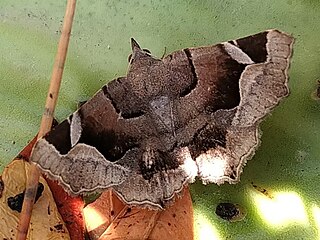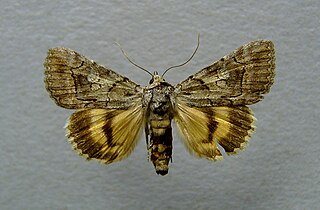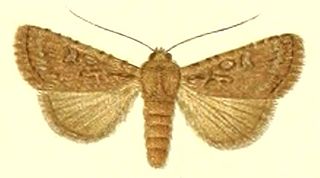
Catocala is a generally Holarctic genus of moths in the family Erebidae. The genus was erected by Franz von Paula Schrank in 1802. The moths are commonly known as underwing moths or simply underwings. These terms are sometimes used for a few related moths, but usually – especially when used in plural, not as part of a species name – they are used to refer to Catocala only.

Zethes insularis is a species of moth in the family Erebidae first described by Jules Pierre Rambur in 1833. The species is found in the warmer parts of the Mediterranean area: Armenia and the Caucasus, Iraq, south-western Iran, Lebanon, Israel, Syria and Jordan.

Lygephila lusoria is a moth of the family Erebidae. The species was first described by Carl Linnaeus in his 1758 10th edition of Systema Naturae. It is found in southern Europe, the Near East and Middle East, European south-eastern Russia, the Caucasus, Turkey and Israel.

Catocala puerpera is a moth of the family Erebidae first described by Michel-Esprit Giorna in 1791. It is found in Mediterranean and sub-Mediterranean areas of the Near East and Middle East and in North Africa.

Catocala conversa is a moth of the family Erebidae first described by Eugenius Johann Christoph Esper in 1787. It is found in the Mediterranean zone and parts of the sub-Mediterranean zone.
Catocala hymenaea is a moth of the family Erebidae first described by Michael Denis and Ignaz Schiffermüller in 1775. It is found from the Middle East to western Asia.

Catocala diversa is a moth of the family Erebidae first described by Carl Geyer in 1826. It is found in Spain, south-eastern France, Italy, the Balkans, European southern Russia and Israel.

Catocala eutychea is a moth of the family Erebidae first described by Georg Friedrich Treitschke in 1835. It is found in the eastern parts of the Mediterranean, especially the Balkans.

Catocala separata is a moth of the family Erebidae first described by Christian Friedrich Freyer in 1846. It is found in the Balkans, the Mediterranean part of southern Turkey and the Levant.
Clytie terrulenta is a moth of the family Erebidae first described by Hugo Theodor Christoph in 1893. It is found in the Near East and Middle East.

Cerocala sana is a moth of the family Erebidae first described by Otto Staudinger in 1901. It is found in North Africa, Iran, Iraq, Bahrain and Israel.
Pericyma albidentaria is a moth of the family Erebidae first described by Christian Friedrich Freyer in 1842. It is found in south-eastern Europe, the Near East, the Middle East, Afghanistan, Iran, Iraq, Syria, Turkey, Cyprus and Israel.
Heteropalpia profesta is a moth of the family Noctuidae first described by Hugo Theodor Christoph in 1887. It is found in the Near East, the Middle East, Iraq, Iran, Afghanistan, Transcaucasia, Turkmenistan and the Arabian Peninsula.
Catocala editarevayae is a moth of the family Erebidae first described by Vasiliy D. Kravchenko et al. in 2008. It is known only from Jordan and Israel.
Catocala olgaorlovae is a moth of the family Erebidae first described by Vasiliy D. Kravchenko et al. in 2008. It is known only from the southern Levant where it was collected in two oases of the central Negev, En Avdat, En Ziq, and from the Egyptian central Sinai Peninsula near Santa Katharina.
Catocala puerperoides is a moth of the family Erebidae first described by Vasiliy D. Kravchenko et al. in 2008. It is restricted to more northern parts of Iran, reaching the southernmost distribution in southeastern Zagros, provinces Azerbayejan-e-Sharqi, Mazandaran, Tehran, Lorestan, Khuzestan and Kohkiluye va Boyer-Ahmad.

Shargacucullia blattariae is a moth of the family Noctuidae. The species was first described by Eugenius Johann Christoph Esper in 1790. It is found in south-eastern Europe, the Near East, Israel and Jordan.
Metalopha liturata is a moth of the family Noctuidae. The species was first described by Hugo Theodor Christoph in 1887. It is widespread but local in the Near East and Middle East from the Levant area to the western Himalayas.

Sympistis exacta is a moth of the family Noctuidae first described by Hugo Theodor Christoph in 1887. It is found from the Near East to central Asia and Mongolia.










